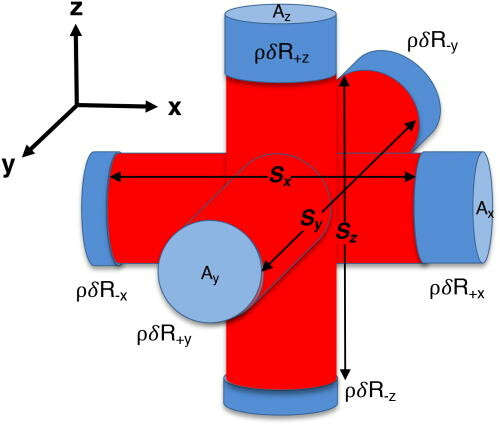‘Piston Model’ Shows Impact of Asymmetry
on NIF Implosions
February 2, 2022
New LLNL research explores the expansion of a classical mechanics model that has been useful for understanding asymmetries in inertial confinement fusion (ICF) implosions on NIF.
The research, featured in a Jan. 3 article in Physics of Plasmas, extends the classical piston model from a two-piston to a six-piston model to capture higher-mode (higher wavelength) asymmetries.
 Abstract rendering of a 3D implosion that is made up of six pistons doing work on a common hot-spot. The configuration is that of three cylinders at right angles to each other. This geometry of the intersection volume is known as a “Steinmetz solid” and the calculation of the volume is non-trivial. The pairs of pistons that lay along a particular coordinate have a time-dependent separations, Sx, Sy, and Sz. Each piston has its own areal density and cross-sectional area.
Abstract rendering of a 3D implosion that is made up of six pistons doing work on a common hot-spot. The configuration is that of three cylinders at right angles to each other. This geometry of the intersection volume is known as a “Steinmetz solid” and the calculation of the volume is non-trivial. The pairs of pistons that lay along a particular coordinate have a time-dependent separations, Sx, Sy, and Sz. Each piston has its own areal density and cross-sectional area. Lead author Omar Hurricane, chief scientist for the LLNL ICF program, said the paper shows that the key asymmetry that degrades performance in an ICF implosion is the asymmetry of the shell areal density at stagnation, and the key mathematical quantity that captures the important physics is the “weighted harmonic mean” of shell areal density (the combined thickness and density of the imploding frozen fusion fuel shell).
The paper also shows that the radius at which the implosion acquires its peak velocity has a very strong impact on fusion performance and has a direct connection to the concept of “coast time”—the time between peak ablation pressure and bang time, or the moment of peak neutron production.
“The bottom line is that we should strive to minimize shell asymmetry at stagnation and minimize the radius of peak velocity in order to maximize ICF fusion performance,” Hurricane said.
“Asymmetry wastes kinetic energy in an implosion—we call this RKE or residual kinetic energy,” Hurricane explained. “The less kinetic energy available to the implosion, the lower the fusion performance. Minimizing asymmetry in our ICF implosions has been a struggle because it integrates asymmetry present in the targets—the capsules in particular—the laser, and the x-ray radiation field in the hohlraum.”
LLNL physicist Dan Casey and Hurricane had the insight to develop a mathematical model analogous to the work of mechanical pistons, such as in an internal combustion engine doing work on a gas.
“For the engine to work properly the pistons should be equal thickness,” Hurricane said, “but for a given set of opposed pistons, if one piston is thick while another piston is thin, the engine won’t compress the fuel-air mixture very well.”
The initial work done to conduct the research relied on analytical mechanics theory; researchers looked at 3D implosions made up of six pistons doing work on a common hot-spot and converted that information into a set of equations that could be solved. The solution gives a testable prediction and set of equations that can be compared to ensemble simulations and data.
The value of this sort of theory is that it dispenses with overly complicated details that ultimately don’t matter much.
Cost of Asymmetry
“One of the most valuable results is a simple but powerful set of relationships between asymmetries and the damage they do to implosion performance,” Casey said. “These tools now allow us to estimate how much (the) asymmetry we observe costs us. In other words, we now know how much asymmetry mattered.”
Added Hurricane: “In inertial confinement fusion, millions of things can potentially be causing us problems, so the value of work like this is to focus our attention on what aspects of implosions are key.
“It’s understanding-building and has the practical result of pointing out what we must fix, and it gives us a way to measure how badly asymmetry is hurting our implosions.”
Hurricane said while the researchers originally only intended to study asymmetry in this work, the important connection of radius of peak velocity to the vague concept of coast time was found unexpectedly by following up on some implications of the mathematical expressions of the work.
This gave researchers a much firmer understanding of why coast time appears to matter so much in NIF experiments, as has been dramatically shown in a recent experiment that achieved more than 1.3 megajoules of energy yield.
Hurricane and Casey were joined on the paper by LLNL researchers Nino Landen, Debbie Callahan, Richard Bionta, Steve Haan, Annie Kritcher, Ryan Nora, Prav Patel, Paul Springer, and Alex Zylstra.
—Michael Padilla
Follow us on Twitter: @lasers_llnl



